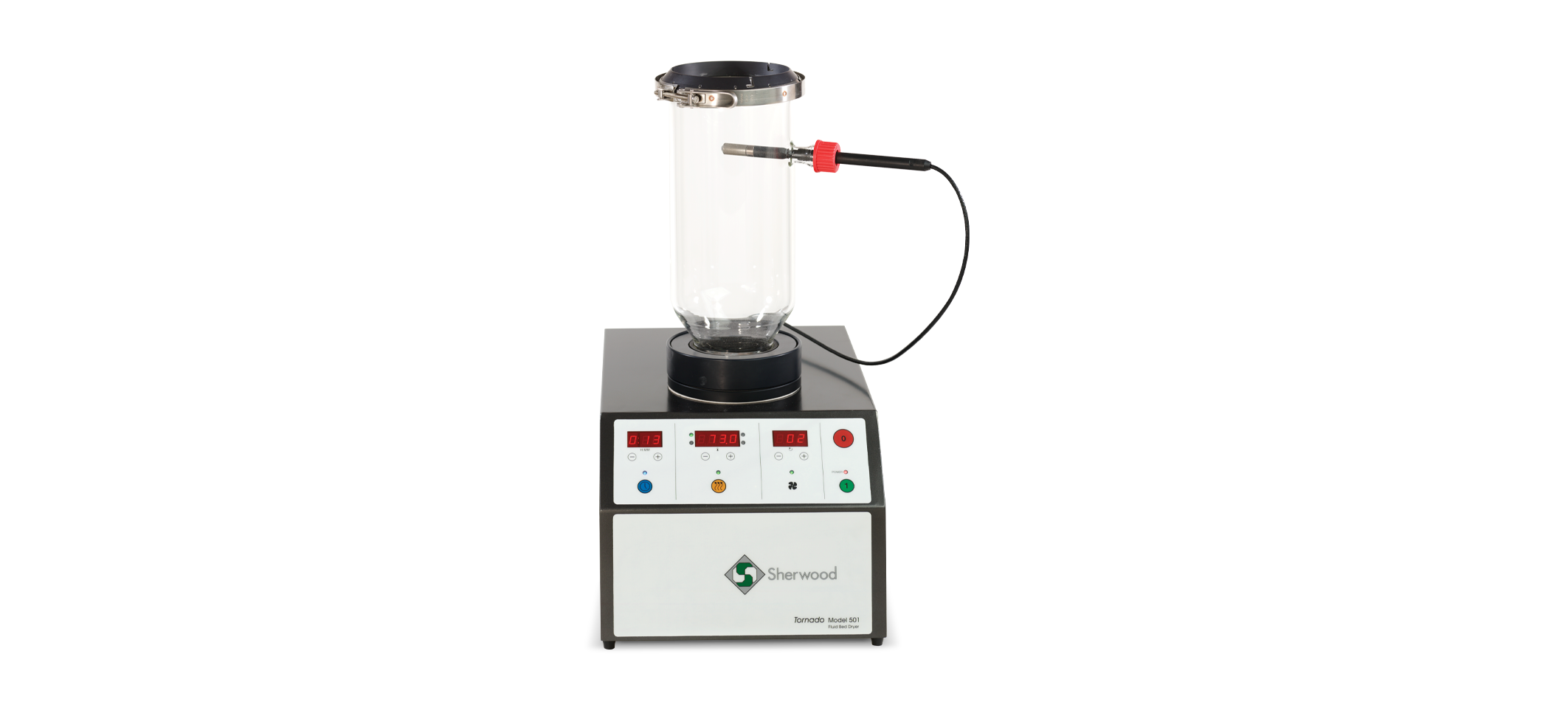
Product Overview
WHAT IS FLUID BED DRYING?
By forcing enough air through a bed of particles, the particle bed may assume a fluid-like state (resembling a boiling liquid). Heating the incoming air and managing air flow rate through the sample, a Fluid Bed Dryer provides thorough mixing and maximum contact of solid with moving air.
FAST
Delivering up to 2.5m3 per minute of air, the Model 501 Fluid Bed Dryer can break up wet samples and ensure vigorous mixing and rapid moisture removal. 5kg of wet “ideal” sample (80% moisture) can be dried in 15-20 minutes (5 Litre tub).
MILD
High air flow rate gives:
- high moisture removal rates at relatively low temperatures
- thorough mixing, so no wet spots requiring extra thermal energy to penetrate
- an air cushion between particles to reduce abrasion and particle size alteration
NON-AGGLOMERATING
Air separated particles prevents lumps and caking, both of which make other drying processes much slower.
HOMOGENEITY OF SAMPLE
Static drying methods leave evaporation residues at the sample surface giving a heterogeneous sample. Fluid Bed Drying achieves the opposite. Mixing during Fluid Bed Drying gives homogeneous samples, making an ideal method of representative sample preparation for subsequent material analyses.
REPRODUCIBLE
Microprocessor control of air flow, inlet air temperature and drying period coupled with fluid bed action gives highly reproducible experiments and finished samples. After preliminary experiments, a known moisture content in the final sample (ideal for tablet forming) or removal of external (surface) moisture only, may be achieved. Drying times to required moisture content may be optimised and drying patterns studied to aid scale-up and plant design.
Without a PC connected the Model 501 Fluid Bed Dryer can run one stored program of up to 16 steps (previously downloaded from a PC), or may be used as a conventional (manually controlled) Fluid Bed Dryer. Additional features of this advanced in-lab dryer technology include:
- Precise air flow feed-back control
- Membrane sealed controls to prevent ingress of particles into the instrument
- Reduced operating noise
Advantages of the Model 501 Fluid Bed Dryer
The Model 501 Fluid Bed Dryer offers significant advantages over conventional drying techniques:
- The high rates of heat and mass transfer ensure much faster and more homogeneous drying than other methods, e.g. oven and vacuum drying
- Drying times range from a few seconds to minutes. Complete drying is usually achieved in under 15 minutes; the exact time for a given sample, airflow rate and temperature setting, being very repeatable. A uniform, reproducible moisture content may also be achieved with experience*
- Materials with moisture contents from a few per cent to over 80 per cent may be dried
- The inlet air temperature range of ambient (+15°C) to 200°C covers most drying operations. Due to good mixing, the sample temperature is uniform and under close control during drying; advantageous for drying heat sensitive materials
The high performance characteristics of this instrument allow it to be used for many applications in addition to drying, such as:
- Quick determination of moisture content (e.g. coal, tobacco, food products) by correlation with weight loss over 5 mins, using specified drying conditions
- Mixing and blending of solids
- Rough classification of particle size (i.e. Stokes Law)
Among the wide range of materials that can be processed are pharmaceuticals, chemicals, minerals, foods, coals, wood chips, plastics, resins etc.
*Microprocessor control of air flow, inlet air temperature and drying period coupled with fluid bed action gives highly reproducible experiments and finished samples. After preliminary experiments, a known moisture content in the final sample (ideal for tablet forming) or removal of external (surface) moisture only, may be achieved. Drying times to required moisture content may be optimised and drying patterns studied to aid scale-up and plant design. Without a PC connected the Model 501 Fluid Bed Dryer can run one stored program of up to 16 steps (previously downloaded from a PC) or may be used as a conventional (manually controlled) Fluid Bed Dryer.
Why choose the Model 501 Fluid Bed Dryer?
The Model 501 can be considered as three Dryers in one:
Standalone Fluid Bed Dryer
The base unit and specified tub assembly for standalone operation.
Microprocessor control of air flow, inlet air temperature and drying period; coupled with fluid bed action gives highly reproducible experiments and finished material samples.
The Model 501 Fluid Bed Dryer is the latest model from Sherwood and has membrane sealed controls to prevent particle ingress and reduced operating noise.
Programmable Fluid Bed Dryer
Dryer base with Specified tub assembly, connected to a PC hosting Sherwood’s Fluid Bed Dryer Software programme.
The software allows control of all variable functions, data monitoring, feedback and creation of multi-step drying protocols designed to dry samples in the most efficient manner. The Model 501 Fluid Bed Dryer can be programmed (via the computer interface) to step through up to 16 drying steps with the following parameters defined and controlled: timer, blower motor speed and inlet air temperature. An optional pulse flow module can also be controlled using the software package. These variable parameters may be monitored and recorded throughout the drying programme. Each programme step may be terminated manually or when a pre-set time or condition (outlet temperature or relative humidity) has been achieved; whichever conditions occurs first.
Analytical Fluid Bed Dryer
The base unit and specified analytical tub assembly (fitted with auxiliary combined temperature and relative humidity probe) connected to a PC hosting Sherwood Scientific Ltd’s Fluid Bed Dryer Software programme.
The ability to monitor in tub (above sample) “outlet” temperature and relative humidity allows for capture of additional data which may be used to understand better the drying behaviour of a material. The ability to transfer that data for post-run processing expands the scope for material drying behaviour studies, for example, material drying curve generation is possible.
How to specify your dryer and accessories
The user has to specify the tub together with the Inlet and Outlet Filters required for their application as follows:
- Material of construction: Glass. (Stainless steel tubs discontinued 2022)
- Tub Volume: 5 Litre, 2 Litre or Mini-Tub (for use with Multi-Tub Base Adapter)
- Tub Type: Ordinary (Bags), Sealed, Analytical (GL32 side port), Dynamic Moisture Analysis, Classifier, Mini, Custom
- Inlet Filter: Material type, pore size
- Outlet Filter: Bag, Top Cap, Material type, pore size
- Bag Material Selection: (Terylene is normally chosen)
Terylene shows greater resistance with acids
Polypropylene is resistant to most chemicals but degrades more rapidly (than the other two) over 100°C
Nomex is an alkali tolerant material suited to sustained high-temperature drying, e.g. ~200°C.
Accessories also to be specified include:
With a Pulse Flow Module (501 86 001) you can pulse air into the sample and adjust the frequency and duration of pulsing. Pulsing the air flow has been found analogous to providing external shaking and mixing. Samples which are difficult to fluidise, like long wet strands of irregular shaped leaves, e.g. tobacco or tea, are ‘blown apart’ and mixed by pulsing the flow.
The addition of a Humidity/Temperature Probe (501 86 500) to the Programmable Fluid Bed Dryer upgrades the instrument to an Analytical Dryer.
RS232 Cable (926 09 052) for downloading program steps to the Fluid Bed Dryer and for collection of data for real-time feedback of temperature and relative humidity.
Software (501 86 700) for control of variable functions, data monitoring, data feedback and creation of multistep drying programs designed to dry samples in the most efficient manner and taking into account the changes in the material’s behaviour as its moisture content changes.
The table below lists the available options for Tubs, Inlet and Outlet Filters for the M501 Programmable Fluid Bed Dryer.
| A | B | C | |||
| TUB UNITS | INLET FILTERS | OUTLET FILTERS | |||
| SIZES | MATERIAL | ||||
| TUB ASSEMBLIES | FILTER BAG OPTIONS | 2 Litre Tub and Base Unit | Glass 50035006 | SS 60 Mesh Support Filter (50035113) with 45 Micron Nylon Inlet Filter (50035110) as standard; Also available SS 250 Mesh 50035114 SS 500 Mesh 50035115 |
Large Filter Bags
Nylon 50035400 |
| 5 Litre Tub and Base Unit | Glass 50035009 | ||||
| Tub assembly 5 Litre with GL32 port supplied with screw fitted blank plate to fit Humidity Probe 50186500 | Glass 50035010 | ||||
| Multi Tub Unit 50035011 |
Small Filter Bags Nylon 50035403 Polypropylene 50035405 Terylene 50035403 |
||||
| Glass Tubs 4 X 50035013 |
SS 60 Mesh Support Filter (50035309) with 45 Micron Nylon Inlet Filter (50035305) as standard; Also available SS 250 Mesh 50035307 SS 500 Mesh 50035308 3 Micron Polyester 50035306 |
||||
| SEALED TUB OPTIONS (Includes Silicon “O” ring & ground glass flange with clamp) |
2 Litre Sealed Glass Tub and Base with Clamp (50035016) | “SS 60 Mesh Support Filter (50035113) with 45 Micron Nylon Inlet Filter (50035110) as standard; Also available SS 250 Mesh 50035114 SS 500 Mesh 50035115 5 Micron Polyester Filter for smallest particle size 50035318 |
Top Cap with 45 Micron Nylon Filter 50035020
Top Cap with SS 250 Mesh Filter 50035021 Top Cap with SS 500 Mesh Filter 50035022 Top Cap with Terylene Filter Bag 50035026 Top Cap + 5 Micron Polyester Filter 50035025 |
||
| 5 Litre Sealed Glass Tub and Base with Clamp (50035014) | |||||
| Tub Assembly 5 Litre Glass Moisture Analysis (Includes ports for sample and Humidity Probe. Both ports supplied with screw fitted blank plates) |
Glass 50135020 | ||||
| Low Density Classifier Assembly | Glass Tub 50035049 | 50035020 fitted as standard to Low Density Classifier | |||
| Multi Tub Unit 50035011 | Glass Tub 50035033 x 4 | Mini Tub, Sealed Tub, Inlet and Outlet sets Mini 45 Micron Nylon Filter Set 50035310 Mini 3 Micron Polyester Filter Set 50035311 Mini SS 250 Mesh Filter Set 50035312 Mini SS 500 Mesh Filter Set 50035313 (SS 60 Mesh Support Filter (50035309) and 45 Micron Nylon Inlet Filter (50035305) as standard) |
|||
Specifying Process
The Sherwood Scientific Model 501 Fluid Bed Dryer is a Lab Scale (Bench Top) dryer with a maximum sample capacity of 5Kg. There is a wide variety of drying tubs (volume), inlet & outlet filters, and other accessories available; both to handle as a wide range of sample types as possible and enhance the capability of the drying system. Therefore, each system requires specifying in some detail to reflect individual customer requirements and sample characteristics in order to prepare an appropriate quotation.
Outlined below are prompts about the sample type and required process and hence implications for component selection:
| SAMPLE TYLE | SYSTEM REQUIREMENTS |
| Sample quantity (weight and/or volume) | A wet sample should occupy about 1/3 of the tub assembly volume. As a sample dries and its density drops, its apparent volume will increase to about ½ the tub volume. Tubs should be purchased that are 3 x the volume of the sample size. The mini tubs are 250ml in capacity and can be used effectively on samples weighing from 5 to 50 grams per tub. Four mini tubs can be dried simultaneously. |
| Moisture content at start of drying process | The Model 501 Fluid Bed Dryer is designed for damp materials not slurries with free water. |
| Flammable solvents present | The Model 501 Fluid Bed Dryer is not spark or explosion proof. It is not suitable for the removal of flammable solvents with low flash points. |
| Particle size-minimum to maximum (not just average) | Minimum particle size in the sample must be known in order to choose a suitable mesh/pore size for inlet and outlet filters to prevent sample falling out the bottom of the tub or being blown out the top. |
| Tub made from glass | Glass is ideal for developing drying processes; you can observe the material’s behaviour as it dries. The optimum flow rate is easy to select judging by the fluidised samples appearance. The operator may estimate the state of dryness, shape and particle size distribution by the appearance of the sample flowing in the tub. |
| Sealed tub or filter bag | Samples with a wide or bi-modal particle distribution are difficult to fluidise without sample overflow into the bag. A sealed top cap is advisable for such samples and any sample with a particle size less than 40 microns. 3 micron polyester filters can be used for mini tubs, 2 and 5 litre tubs. These filters are effective for 5 to 25 micron particles but greatly reduce air flow rate through the sample. Drying times normally occurring between 10 to 30 minutes can take up to several hours. Many of the main advantages of fluid bed drying may be lost |
| DRYING PROCESS | ACCESSORIES REQUIRED |
| Simple dryer | Select a tub |
| Multistep drying process | Add software and RS232 cable |
| In-time drying progress feedback | Add Moisture/Humidity Probe which means you have to select a tub with a GL32 side port. Only the 5 litre glass tub assemblies, 500 35 010 and 501 35 020 can have an inlet for the outlet humidity and temperature probe. Only these tubs can fully utilise all the features on the M501. |
| Data collection | Add software and RS232 cable |
| Data manipulation with drying curve generation | Add software and RS232 cable |
| Add sample to dryer without removing outlet filter | Specify Dynamic Moisture Analysis tub 501 35 020 |
Brochure
Fluid-bed-dryer-brochure.pdfModel 501 Fluid Bed Dryer Configurations – Examples
With a large range of tub assemblies, construction materials and software the Model 501 Fluid Bed Dryer offers a flexible platform able to assist with:
- Studies of material drying behaviour
- The optimisation and scale-up of drying processes
- Preparation of small sample batches for subsequent materials studies
5 Litre Glass Tub
Model 501 Fluid Bed Dryer shown with 5 Litre Glass Tub
(500 35 008) and Large Filter Bag. Remember to specify Tub Inlet Filter (mesh size and material type) and bag material required.
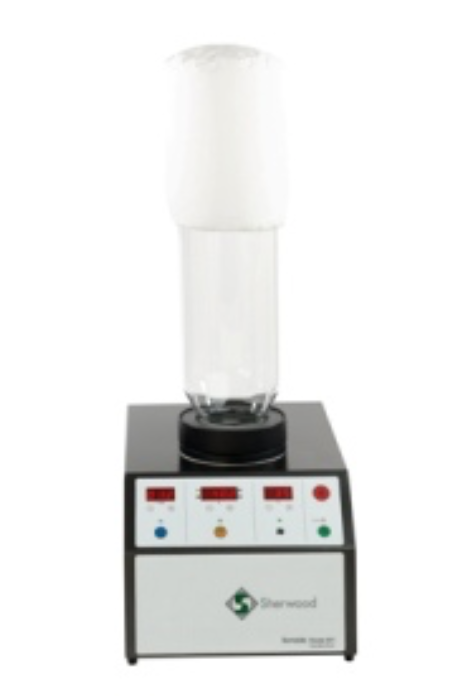
5 Litre Glass Tub with side port
Model 501 Fluid Bed Dryer shown with 5 Litre Glass Tub with GL32 side port (500 35 010), Temperature/Humidity Probes and Large Filter Bag.
Please specify Tub Inlet Filter (mesh size and material type) and bag material required and remember to order the Temperature/Humidity Probe (501 86 500).
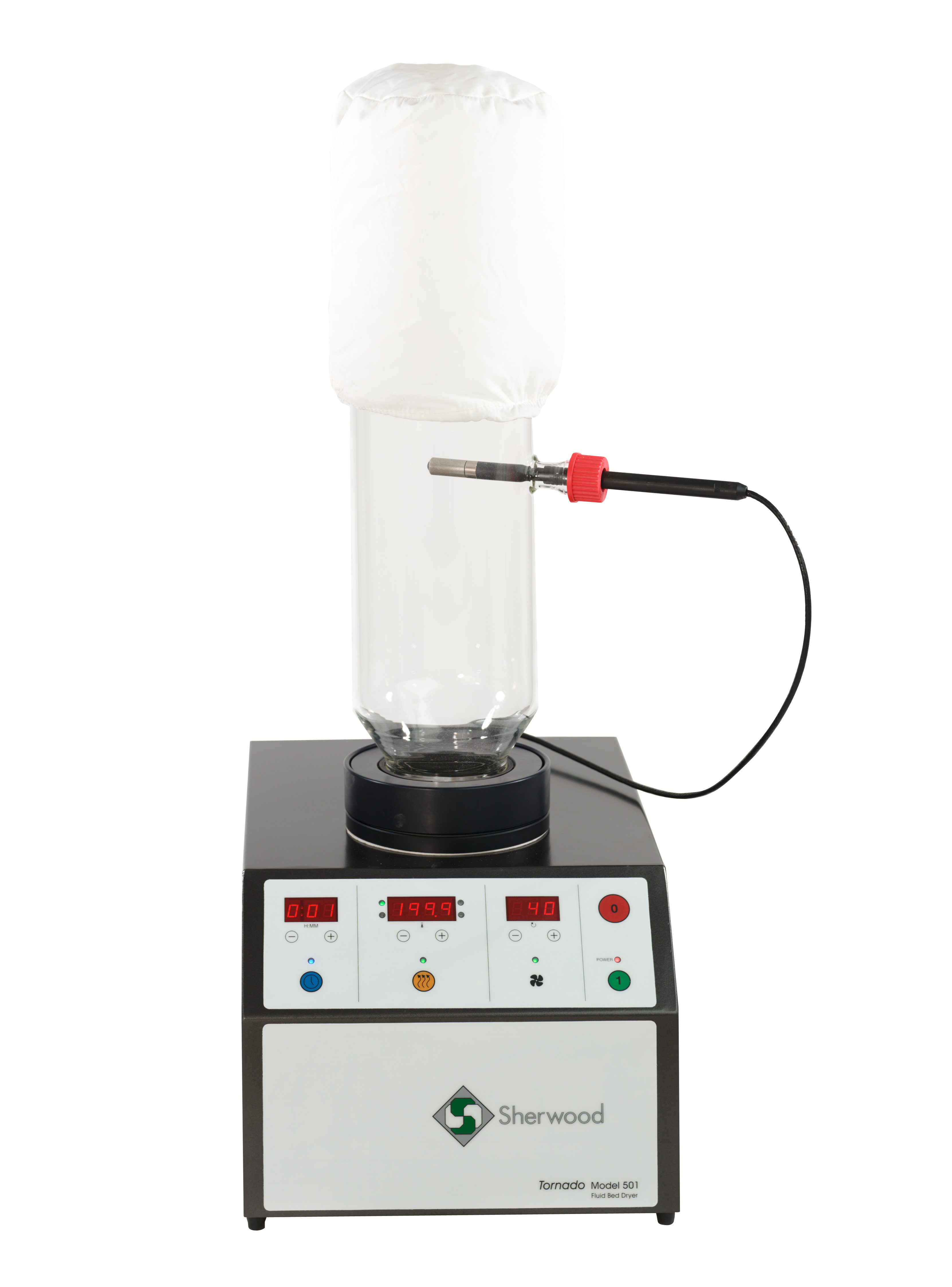
5 Litre glass Dynamic Moisture Analysis Tub
Model 501 Fluid Bed Dryer shown with 5 Litre glass Dynamic Moisture Analysis Tub (501 35 020) with Sealed Top Cap Assembly and GL32 side port, Temperature/Humidity Probe plus side port for samples.
Please specify Tub Inlet Filter (mesh size and material type) and Top Cap Filter (required mesh size and material type) and remember to order the Temperature/Humidity Probe
(501 86 500).
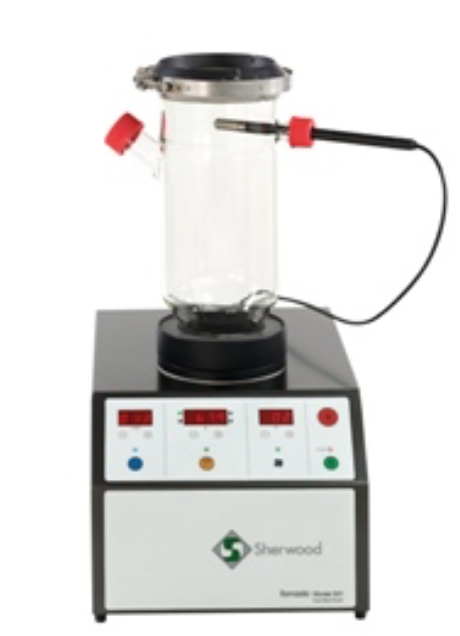
Multi-Tub unit and Glass Mini-Tubs
Model 501 Fluid Bed Dryer shown with Multi-Tub unit
(500 35 011) and Glass Mini-Tubs with fixed Top Caps and Bags for drying of small batches of sample. Mixture of Top Caps and Bags shown are for illustration purposes only.
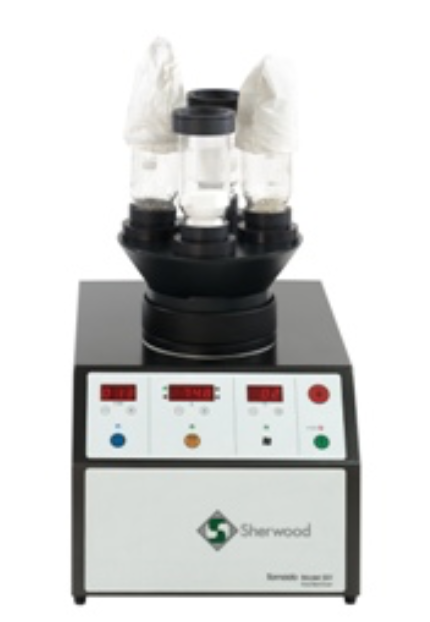
Low Density Classifier
Model 501 Fluid Bed Dryer shown with Low Density Classifier (500 35 049) which allows for fractionation of samples with wide particle size/density distribution and collection of fractions within that range. It also allows separation of desirable sample elements from bulk samples, for example, removal of tree seed “wings” from the seeds.
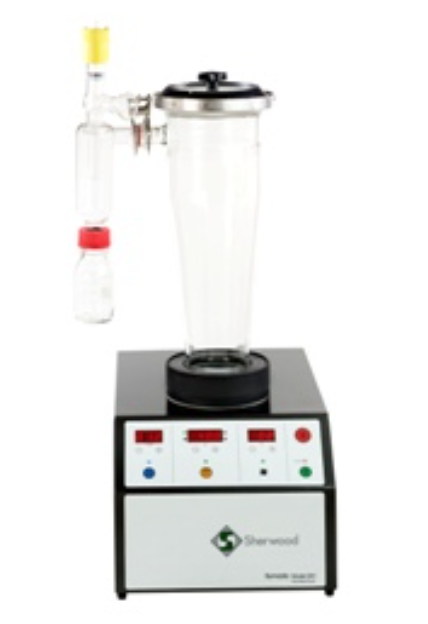
Typical Uses:
- Rapid drying of many types of chemicals, foodstuffs and minerals with up to 80% moisture content
- Drying of heat sensitive materials at low temperatures under accurately controlled and uniform conditions
- Determining the moisture content of substances such as adhesives, tobacco, dried foods and building materials
- Converting cake or precipitate from chemical or pharmaceutical production into powder or granular form
- Determining thermodynamic parameters for industrial dryer design e.g. heat/mass balance, thermal efficiency and calculating heat transfer coefficients
- Obtaining uniform coatings of evaporation residues on particles
- Simulating large scale process installations to monitor quality, efficiency and carry out small batch treatment
Inlet air temperature, blower motor speed, in-tub temperature and relative humidity can all be recorded against time (using software and the temperature humidity probe).
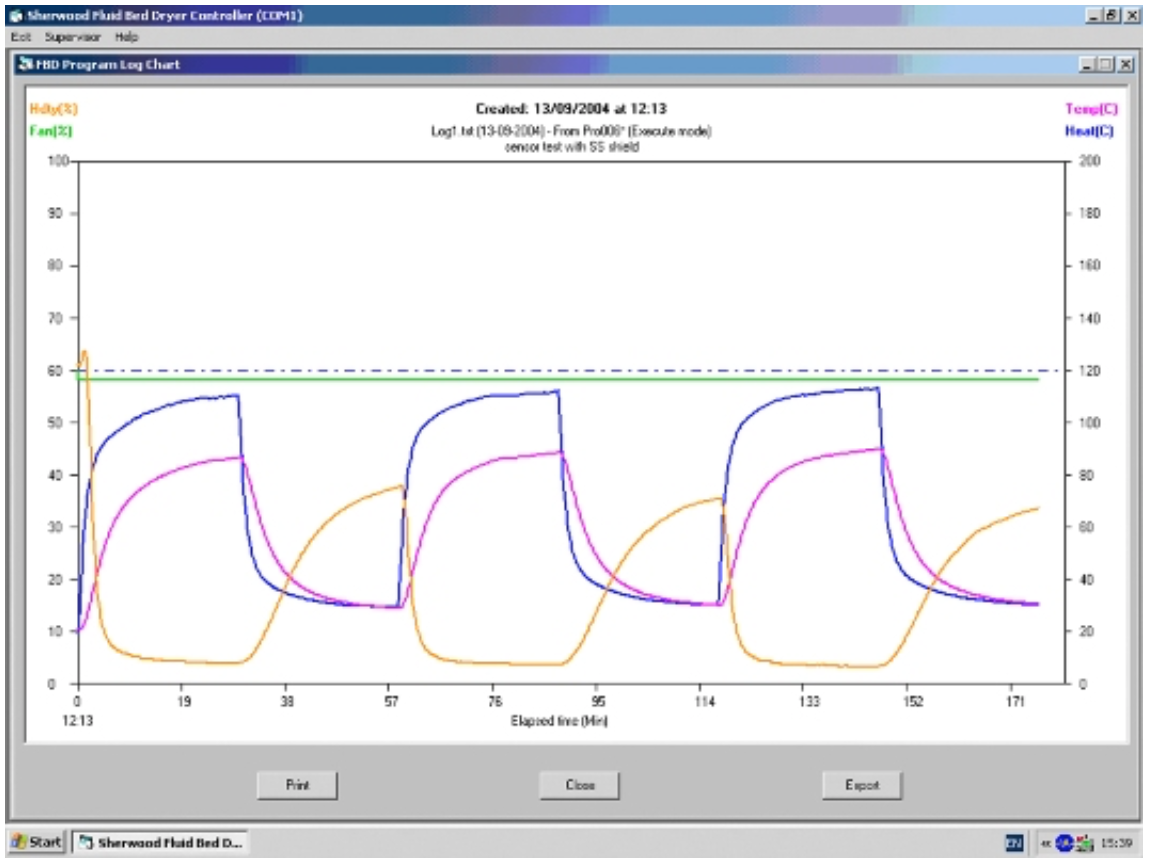
Overall Dimensions:
Bag : H:260mm
Tub: H:2L = 210 mm / 5L = 380mm
FBD: H:275mm / L: 480mm / W: 320mm
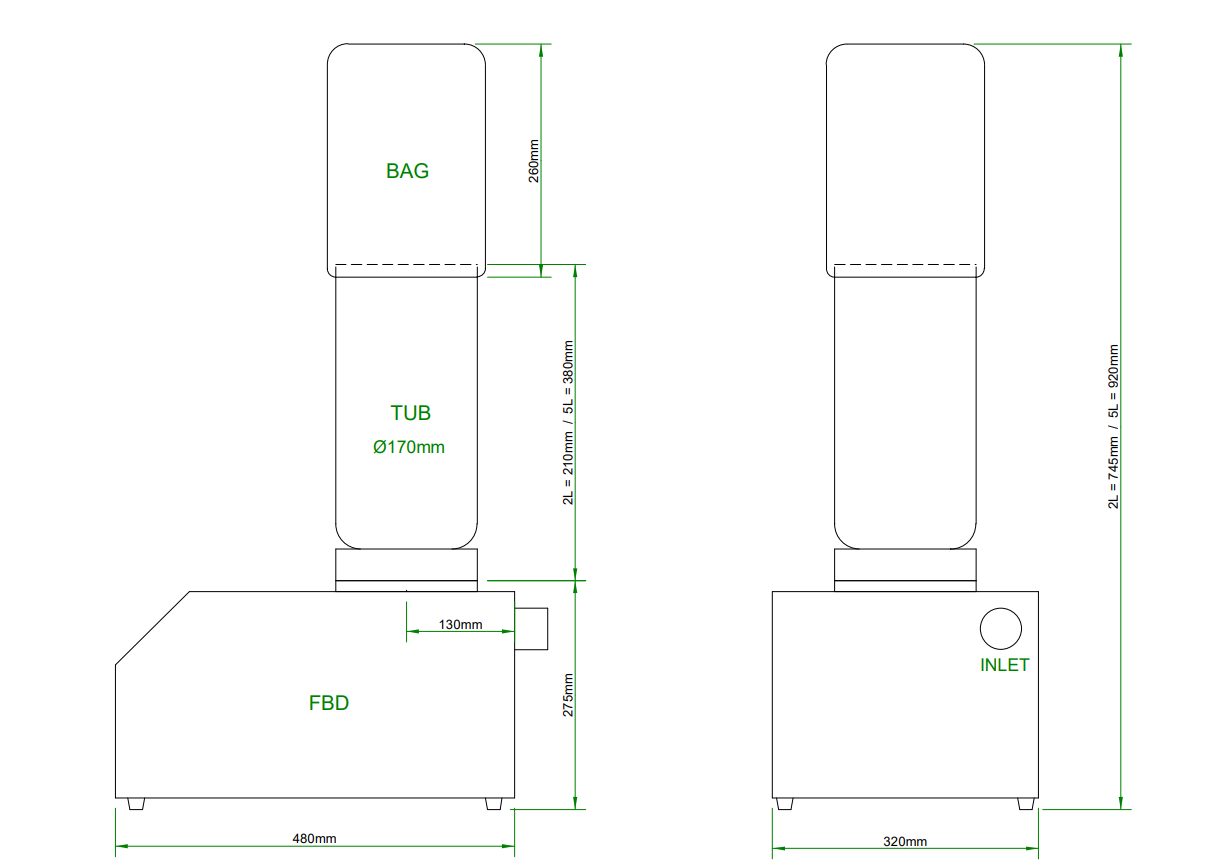
The Basics: Model 501 Programmable Fluid Bed Dryer
The basic Model 501 Fluid Bed Dryer incorporates an air pump, heating coil and temperature measurement (with control and timer). Air is drawn through an inlet filter, passed over a heating element and forced through a support filter (which holds the weight of the sample) and a tub inlet filter (selected for pores smaller than the sample particle size). The air passes through the sample contained within a tub (glass or stainless) and finally through an outlet filter which can be a filter bag. Bag material is selected to be chemically inert to emitted sample vapours. Alternatively, “Sealed” tub assemblies are available, where a top cap (which has an outlet filter and support filter) seals onto a flanged tub with a silicon O-ring and clamp (for particles less than 40 microns in size). Sealed tubs are only available in glass.
The microprocessor controlled Model 501 Fluid Bed Dryer can be used as a standalone unit or programmed via a computer interface to step through as many as sixteen drying stages with each stage
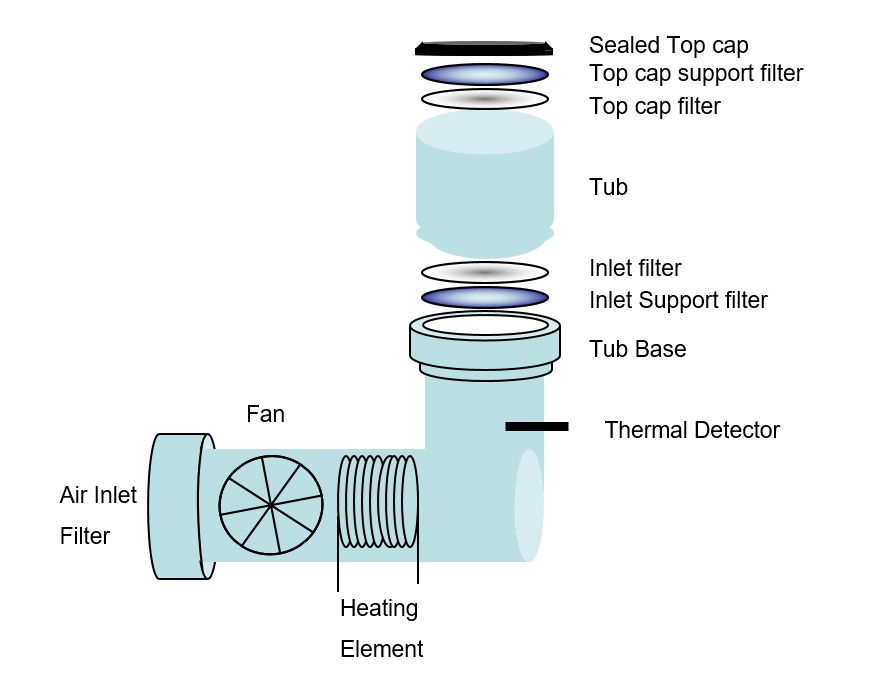
The following data is captured and stored having the following parameters defined controlled and monitored:
Inlet air temperature
Blower motor speed
Pulse flow function (for difficult to fluidise samples)
Without a computer interface the Programmable Fluid Bed Dryer can run one stored program of up to sixteen steps, or can be used as a conventional, manually adjusted, dryer.
Additional features of this advanced in-lab dryer include: precise air flow control and membrane sealed controls to prevent ingress of particles into the instrument.
The following items are required to achieve programmable drying:
The Fluid Bed Dryer Software
RS232 Computer Interface Cable
Computer
The addition of a Humidity/Temperature Probe to the Programmable Fluid Bed Dryer upgrades the instrument to an Analytical Dryer.
The following data is captured and stored:
Air flow rate
Inlet temperature
Pulse flow condition
Outlet temperature
Relative humidity
Each drying step can be programmed to terminate either on duration of step, humidity level achieved or outlet temperature reached. The Analytical Fluid Bed Dryer can be used to monitor both manual as well as programmed operations. The captured data can be transferred to an Excel Worksheet, which allows drying curves and moisture calculations to be performed.
